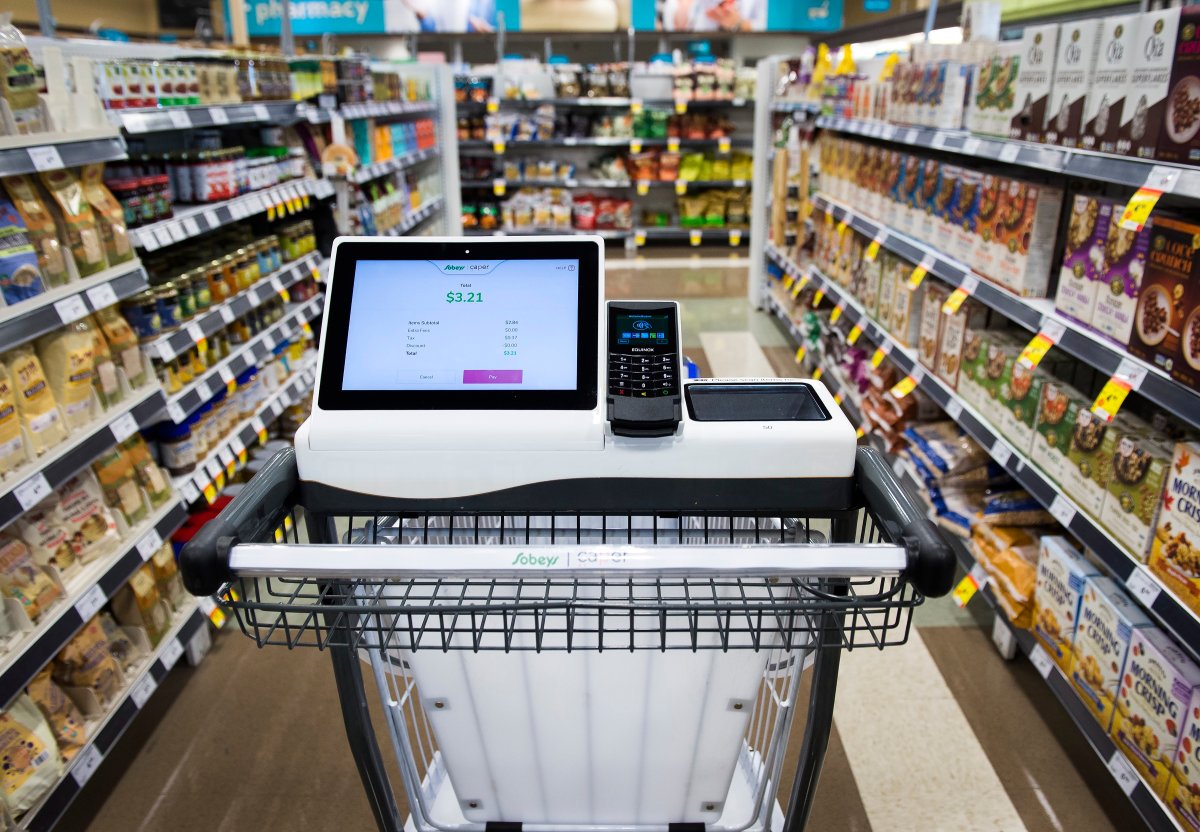Shoppers pushing one of 10 new smart carts at a Sobeys store can scan their items on the spot, track their total bill and accept payment, which means they can skip the cashier or self-checkout altogether.

The artificial intelligence-equipped carts are the latest aspect in grocers’ efforts to streamline the shopping experience as consumers became increasingly accustomed to convenience.
Despite all the advancements found in a modern grocery store, customers are still required to gather their groceries, unload them at checkout, and then place their purchases into bags.
“This helps remove a little bit of that friction,” said Jacquelin Weatherbee, communications director for Sobeys.
The grocer announced late last month it purchased 10 smart carts that it is starting to pilot at an Oakville, Ont., location.
For now, shoppers using the carts must allow it to scan each item they place inside. Eventually, the cart, which “gets smarter over time,” will learn what each product is and the company will remove the scanning requirement, said Weatherbee.
The cart also weighs produce, keeps a running tally of the total bill, and accepts payment. One feature it lacks is a seat to hold a child.
“It really limits the amount of time you’re going from product to stand to belt to bag for the customer,” said Weatherbee.

Sobeys hopes to develop the technology to include suggestions about missing ingredients for recipes based on what is already in the cart and the ability for customers to upload their shopping lists.
The carts — created by New York-based Caper Inc., which did not respond to an interview request — show one way grocers turn to tech to eliminate the need for traditional checkouts.
Amazon debuted its Amazon Go system in Seattle in 2018. Shoppers must have an Amazon account and the Amazon Go app, which grants them access to the store. Customers take the products they want and leave. In-store technology tracks the purchase and charges their app.
Amazon now operates 18 of the Go stores in four cities in America — with six more shops on the way, according to its website. With the tech titan’s acquisition of Whole Foods, including its Canadian locations, it’s possible that the concept will one day land in Canada.
READ MORE: Canadians can expect rising food prices due to cost pressures, U.S. trade war: grocery CEOs
Weatherbee said Sobeys likes its smart cart solution because of the ability to add functionality over time.
Loblaw Companies Ltd. quietly rolled out a pilot in a similar vein last year.
Now in eight stores, customers can use the company’s app on their cellphones to scan items as they shop. The app aggregates all the products into one bar code, which can be scanned by a cashier or at the self-checkout when customers pay.

“There’s still quite a few improvements to be made on that product,” said Lauren Steinberg, a vice president at Loblaw digital. That includes adding the ability to pay within the app rather than at the checkout, which the company plans to roll out next year.
Walmart Canada shifted to a similar system that relies on a consumer’s phone this year after testing a handheld device, much like a wand, that allowed customers to scan products while they shopped.
The former scan-and-go system reportedly created frustration for some shoppers.
READ MORE: 10 things you can do to reduce food waste in your home
“Most customers like to actually use their own device, touch their own device, feel their own device,” said Alykhan Kanji, vice-president of format development at Walmart Canada.
When the company launched scan and go, he added, they hypothesized the process would shift to consumer phones eventually.
Shoppers at six Walmart Canada locations in the Greater Toronto Area can now test the program, dubbed Fastlane, via the Walmart app.

Already the company has made changes based on consumer response.
Customers balked at suddenly having to weigh produce to give the app the per kilogram cost of, for example, a bunch of bananas. Walmart introduced per unit pricing for as much produce as possible in response so shoppers can now scan the food without having to weigh it.
Canadians, especially younger demographics that are rapidly becoming one of the most important consumer groups, increasingly expect a more tech-savvy shopping experience, said Joel Gregoire, associate director for Mintel’s Canada food and drinks reports.
READ MORE: Here’s how much more Canadians will likely spend on groceries in 2019
“They’ve grown up at a time when they are very much tied to their technology — to the point where this is all they’ve ever really known,” he said.
“And for grocers to have a competitive advantage or to be relevant, they have to make sure they offer an experience that is linked to their technology.”
But Gregoire said there’s benefits beyond traffic.

Technology could lower labour costs in the long run, as it replaces the need for cashiers. The grocers tended to believe they would redistribute staff formerly tied to the cash register onto the store floor — even further enhancing customer experience.
The data gathered from these apps could help companies learn more about their customers as well, said Gregoire.
If the smart carts and apps can track how customers move through the store, that information can help grocers improve their layouts, he said.
“I’m only kind of scratching the surface in terms of how that can be used, but certainly data is king in retail.”
- Trudeau tight-lipped on potential U.S. TikTok ban as key bill passes
- Canadian man dies during Texas Ironman event. Her widow wants answers as to why
- Hundreds mourn 16-year-old Halifax homicide victim: ‘The youth are feeling it’
- On the ‘frontline’: Toronto-area residents hiring security firms to fight auto theft



Comments